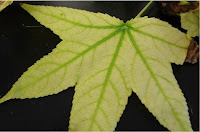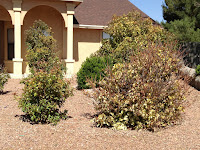 |
| Iron chlorosis on a sweetgum leaf (Photo: NMSU-PDC) |
plants left untreated may exhibit severe symptoms and have an overall unthrifty appearance.
Iron
Deficiency is one of the most common nutrient deficiencies in
all sorts of landscape plants. Some of the most commonly submitted plants for diagnosis include: Photinia, willows, mulberry, maples, sycamore, Poplars, roses, apples, pears, Hawthorne, stone fruits and pecan. Iron is a critical element for good growth and green color. Iron may be plentiful in the soil, but it is tightly bound to the soil particles in high pH (alkaline and calcareous) soils. Under these conditions, the iron is
unavailable for plant use.
all sorts of landscape plants. Some of the most commonly submitted plants for diagnosis include: Photinia, willows, mulberry, maples, sycamore, Poplars, roses, apples, pears, Hawthorne, stone fruits and pecan. Iron is a critical element for good growth and green color. Iron may be plentiful in the soil, but it is tightly bound to the soil particles in high pH (alkaline and calcareous) soils. Under these conditions, the iron is
 |
| Iron chlorosis on Photinia shrub> (Photo: NMSU-PDC) |
The classic
symptom of iron deficiency is interveinal chlorosis where the leaf turns yellow
and the veins remain green. In very severe cases, leaves may turn white in
color or develop necrotic spots,
which can look like a fungal infection, on the affected leaves. Over time, plants which remain untreated will start to dieback, become unsightly in appearance and may eventually die. Symptoms can be exacerbated when shrubs are planted in heavy, poorly drained soils
which can look like a fungal infection, on the affected leaves. Over time, plants which remain untreated will start to dieback, become unsightly in appearance and may eventually die. Symptoms can be exacerbated when shrubs are planted in heavy, poorly drained soils
 |
| Iron chlorosis on a Bradford pear tree (Photo: NMSU-PDC) |
 |
| Dieback on Bradford pear caused by iron deficiency (Photo: NMSU-PDC) |

No comments:
Post a Comment